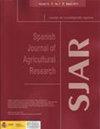Effect of male pig immunocastration on physical and chemical characteristics of Teruel dry-cured hams
IF 0.8
4区 农林科学
Q3 AGRICULTURE, MULTIDISCIPLINARY
引用次数: 0
Abstract
Aim of study: To evaluate the effect of the type of male castration (surgical vs. immunological) on the characteristics of Teruel dry-cured hams. Area of study: Teruel and Zaragoza (Spain). Material and methods: A total of 14 dry-cured hams from Duroc × (Landrace × Large White) male pigs intended for the Spanish Protected Designation of Origin ˈTeruel hamˈ were used. Half of them belonged to surgical castrated males (SCM) and the other half to immunocastrated males (IM). Ham weight losses during processing, physical and chemical characteristics were analyzed. Main results: There were no differences (p>0.05) due to the type of castration in ham weight losses throughout processing, thickness of subcutaneous fat, marbling, maximum stress and intramuscular fatty acid profile. However, hams from IM presented lower (p<0.05) chroma than those from SCM. The type of castration had limited influence on chemical composition; only potassium nitrate and retinol contents were affected (p<0.05), being lower in IM than in SCM. For volatile compounds, IM showed lower (p<0.05) percentages of total alcohols and sulfur compounds and higher (p=0.012) proportion of total acids than SCM. All the hams had negligible androstenone content but IM presented higher (p<0.05) skatole and indole concentrations than SCM, being these levels low. Research highlights: The type of castration in male pigs seems to have scarce influence on the quality of Teruel dry-cured hams, and therefore, immunocastration could be considered as a possible alternative to surgical castration.公猪免疫去势对特鲁埃尔干腌火腿理化特性的影响
研究目的:评估男性阉割类型(手术与免疫)对Teruel干腌火腿特性的影响。研究领域:特鲁埃尔和萨拉戈萨(西班牙)。材料和方法:选用杜洛克×(长白×大白)公猪的14只干腌火腿,用于西班牙保护原产地的Teruel火腿。其中一半属于手术阉割男性(SCM),另一半属于免疫阉割男性(IM)。分析了火腿加工过程中的失重、理化特性。主要结果:由于去势类型、皮下脂肪厚度、大理石花纹、最大应力和肌肉内脂肪酸分布,在整个加工过程中火腿的体重减轻方面没有差异(p>0.05)。然而,IM火腿的色度低于SCM火腿(p<0.05)。阉割的类型对化学成分的影响有限;只有硝酸钾和视黄醇含量受到影响(p<0.05),IM组低于SCM组。对于挥发性化合物,IM显示出比SCM更低(p<0.05)的总醇和硫化合物百分比,以及更高(p=0.012)的总酸比例。所有火腿的雄烯酮含量可忽略不计,但IM的粪酚和吲哚浓度高于SCM(p<0.05),因为这些水平较低。研究重点:雄猪的阉割类型似乎对Teruel干腌火腿的质量影响不大,因此,免疫阉割可以被认为是手术阉割的一种可能替代方案。
本文章由计算机程序翻译,如有差异,请以英文原文为准。
求助全文
约1分钟内获得全文
求助全文
来源期刊

Spanish Journal of Agricultural Research
农林科学-农业综合
CiteScore
2.00
自引率
0.00%
发文量
60
审稿时长
6 months
期刊介绍:
The Spanish Journal of Agricultural Research (SJAR) is a quarterly international journal that accepts research articles, reviews and short communications of content related to agriculture. Research articles and short communications must report original work not previously published in any language and not under consideration for publication elsewhere.
The main aim of SJAR is to publish papers that report research findings on the following topics: agricultural economics; agricultural engineering; agricultural environment and ecology; animal breeding, genetics and reproduction; animal health and welfare; animal production; plant breeding, genetics and genetic resources; plant physiology; plant production (field and horticultural crops); plant protection; soil science; and water management.
 求助内容:
求助内容: 应助结果提醒方式:
应助结果提醒方式:


